Enhancing Urban Flood Susceptibility Assessment by Capturing the Features of the Urban Environment
Abstract
:1. Introduction
2. Study Area and Data
2.1. Study Area
2.2. UF Spatial Database
3. Methodology
3.1. UFS Evaluation
- GBDT
- 2.
- XGBoost
- 3.
- RF
3.2. Negative Sample Screening
3.3. Quantification of Factors’ Contributions
4. Results and Analyses
4.1. Comparisons of ML Results
4.2. Comparisons of the TS and TSU Scenarios
4.3. Spatial Analyses
5. Discussion
5.1. Implications of This Study
5.2. Policy Implications for Urban Flood Management
5.3. Limitations and Prospects
6. Conclusions
Supplementary Materials
Author Contributions
Funding
Data Availability Statement
Acknowledgments
Conflicts of Interest
References
- Rafiei-Sardooi, E.; Azareh, A.; Choubin, B.; Mosavi, A.H.; Clague, J.J. Evaluating urban flood risk using hybrid method of TOPSIS and machine learning. Int. J. Disaster Risk Reduct. 2021, 66, 102614. [Google Scholar] [CrossRef]
- Tong, J.; Gao, F.; Liu, H.; Huang, J.; Liu, G.; Zhang, H.; Duan, Q. A study on identification of urban waterlogging risk factors based on satellite image semantic segmentation and XGBoost. Sustainability 2023, 15, 6434. [Google Scholar] [CrossRef]
- Tehrany, M.S.; Biswajeet, P.; Mustafa Neamah, J. Spatial prediction of flood susceptible areas using rule based decision tree (DT) and a novel ensemble bivariate and multivariate statistical models in GIS. J. Hydrol. 2013, 504, 69–79. [Google Scholar] [CrossRef]
- Zhou, H.; Liu, J.; Gao, C.; Zhou, Y.; Hu, Z.; Xu, X.; Song, K. Development of an urban stormwater model considering effective impervious surface: I: Theory and development of model. Adv. Water Sci. 2022, 33, 474–484. [Google Scholar]
- Lin, L.; Tang, C.; Liang, Q.; Wu, Z.; Wang, X.; Zhao, S. Rapid urban flood risk mapping for data-scarce environments using social sensing and region-stable deep neural network. J. Hydrol. 2023, 617, 128758. [Google Scholar] [CrossRef]
- Randall, M.; Sun, F.; Zhang, Y.; Jensen, M.B. Evaluating Sponge City volume capture ratio at the catchment scale using SWMM. J. Environ. Manag. 2019, 246, 745–757. [Google Scholar] [CrossRef]
- Djordjević, S.; Prodanović, D.; Maksimović, Č.; Ivetić, M.; Savić, D. SIPSON–simulation of interaction between pipe flow and surface overland flow in networks. Water Sci. Technol. 2005, 52, 275–283. [Google Scholar] [CrossRef] [PubMed]
- Araya-Muñoz, D.; Metzger, M.J.; Stuart, N.; Wilson, A.M.W.; Carvajal, D. A spatial fuzzy logic approach to urban multi-hazard impact assessment in Concepción, Chile. Sci. Total Environ. 2017, 576, 508–519. [Google Scholar] [CrossRef]
- Chen, A.S.; Evans, B.; Djordjević, S.; Savić, D.A. Multi-layered coarse grid modelling in 2D urban flood simulations. J. Hydrol. 2012, 470, 1–11. [Google Scholar] [CrossRef]
- Zhang, S.; Pan, B. An urban storm-inundation simulation method based on GIS. J. Hydrol. 2014, 517, 260–268. [Google Scholar] [CrossRef]
- Zhang, W.; Hu, B.; Liu, Y.; Zhang, X.; Li, Z. Urban Flood Risk Assessment through the Integration of Natural and Human Resilience Based on Machine Learning Models. Remote Sens. 2023, 15, 3678. [Google Scholar] [CrossRef]
- Jianfeng SU, N.; Chao, M.A.; Jinshu, H.U.; Tiesheng, Y.; Jiajun, G.; Hui, X. Susceptibility evaluation of geological hazard by coupling grey relational degree and analytic hierarchy process: A case of Chongtou Town, Yunhe County, Zhejiang Province. J. Engin. Geo. 2023, 31, 538–551. [Google Scholar]
- Yang, Y.; Ji, J. An Earthquake Auxiliary Decision Making System Integrating Microblog Data. North China Earthq. Sci. 2024, 42, 30–37. [Google Scholar]
- Lyu, H.-M.; Yin, Z.-Y. Flood susceptibility prediction using tree-based machine learning models in the GBA. Sustain. Cities Soc. 2023, 97, 104744. [Google Scholar] [CrossRef]
- Bera, S.; Arup, D.; Taraknath, M. Evaluation of machine learning, information theory and multi-criteria decision analysis methods for flood susceptibility mapping under varying spatial scale of analyses. Remote Sens. Appl. Soc. Environ. 2022, 25, 100686. [Google Scholar]
- Zhang, G.; Wang, M.; Kai, L. Forest fire susceptibility modeling using a convolutional neural network for Yunnan province of China. Int. J. Disaster Risk Sci. 2019, 10, 386–403. [Google Scholar] [CrossRef]
- Zhou, Y.; Wu, Z.; Jiang, M.; Xu, H.; Yan, D.; Wang, H.; He, C.; Zhang, X. Real-time prediction and ponding process early warning method at urban flood points based on different deep learning methods. J. Flood Risk Manag. 2024, 17, e12964. [Google Scholar] [CrossRef]
- Youssef, A.M.; Pourghasemi, H.R.; Mahdi, A.M.; Matar, S.S. Flood vulnerability mapping and urban sprawl suitability using FR, LR, and SVM models. Environ. Sci. Pollut. Res. 2023, 30, 16081–16105. [Google Scholar] [CrossRef]
- Norallahi, M.; Hesam Seyed, K. Urban flood hazard mapping using machine learning models: GARP, RF, MaxEnt and NB. Nat. Hazards 2021, 106, 119–137. [Google Scholar] [CrossRef]
- Darabi, H.; Rahmati, O.; Naghibi, S.A.; Mohammadi, F.; Ahmadisharaf, E.; Kalantari, Z.; Haghighia, A.T.; Soleimanpour, S.M.; Tiefenbacheri, J.P.; Bui, D.T. Development of a novel hybrid multi-boosting neural network model for spatial prediction of urban flood. Geocarto Int. 2022, 37, 5716–5741. [Google Scholar] [CrossRef]
- Taromideh, F.; Fazloula, R.; Choubin, B.; Emadi, A.; Berndtsson, R. Urban flood-risk assessment: Integration of decision-making and machine learning. Sustainability 2022, 14, 4483. [Google Scholar] [CrossRef]
- Motta, M.; Miguel de Castro, N.; Pedro, S. A mixed approach for urban flood prediction using Machine Learning and GIS. Int. J. Disaster Risk Reduct. 2021, 56, 102154. [Google Scholar] [CrossRef]
- Tang, X.; Li, J.; Liu, W.; Yu, H.; Wang, F. A method to increase the number of positive samples for machine learning-based urban waterlogging susceptibility assessments. In Stochastic Environmental Research and Risk Assessment; Springer: Berlin/Heidelberg, Germany, 2021; pp. 1–18. [Google Scholar]
- Rousseau, A.N.; Stéphane, S.; Marie-Laurence, B. Flood water storage using active and passive approaches-Assessing flood control attributes of wetlands and riparian agricultural land in the Lake Champlain-Richelieu River watershed. 2020. Available online: https://espace.inrs.ca/id/eprint/11334/1/R2000.pdf (accessed on 7 April 2025).
- Fang, J.; Xu, W.; Kong, F.; Shi, P. Advances in the study of climate change impacts on flood disaster. Adv. Earth Sci. 2014, 29, 1085–1093. [Google Scholar]
- Parvin, F.; Ali, S.A.; Calka, B.; Bielecka, E.; Linh NT, T.; Pham, Q.B. Urban flood vulnerability assessment in a densely urbanized city using multi-factor analysis and machine learning algorithms. Theor. Appl. Climatol. 2022, 149, 639–659. [Google Scholar] [CrossRef]
- Zhao, G.; Pang, B.; Xu, Z.; Peng, D.; Xu, L. Assessment of urban flood susceptibility using semi-supervised machine learning model. Sci. Total Environ. 2019, 659, 940–949. [Google Scholar] [CrossRef]
- Bui, D.T.; Hoang, N.D.; Martínez-Álvarez, F.; Ngo, P.T.T.; Hoa, P.V.; Pham, T.D.; Samui, P.; Costache, R. A novel deep learning neural network approach for predicting flash flood susceptibility: A case study at a high frequency tropical storm area. Sci. Total Environ. 2020, 701, 134413. [Google Scholar]
- Tehrany, M.S.; Pradhan, B.; Mansor, S.; Ahmad, N. Flood susceptibility assessment using GIS-based support vector machine model with different kernel types. Catena 2015, 125, 91–101. [Google Scholar] [CrossRef]
- Rahmati, O.; Darabi, H.; Panahi, M.; Kalantari, Z.; Naghibi, S.A.; Ferreira, C.S.S.; Kornejady, A.; Karimidastenaei, Z.; Mohammadi, F.; Stefanidis, S.; et al. Development of novel hybridized models for urban flood susceptibility mapping. Sci. Rep. 2020, 10, 12937. [Google Scholar] [CrossRef]
- Zhao, J.; Wang, J.; Abbas, Z.; Yang, Y.; Zhao, Y. Ensemble learning analysis of influencing factors on the distribution of urban flood risk points: A case study of Guangzhou, China. Front. Earth Sci. 2023, 11, 1042088. [Google Scholar] [CrossRef]
- Wang, M.; Li, Y.; Yuan, H.; Zhou, S.; Wang, Y.; Ikram, R.M.A.; Li, J. An XGBoost-SHAP approach to quantifying morphological impact on urban flooding susceptibility. Ecol. Indic. 2023, 156, 111137. [Google Scholar] [CrossRef]
- Li, Y.; Osei, F.B.; Hu, T.; Stein, A. Urban flood susceptibility mapping based on social media data in Chengdu city, China. Sustain. Cities Soc. 2023, 88, 104307. [Google Scholar] [CrossRef]
- Sun, N.; Li, C.; Guo, B.; Sun, X.; Yao, Y.; Wang, Y. Urban flooding risk assessment based on FAHP–EWM combination weighting: A case study of Beijing. Geomat. Nat. Hazards Risk 2023, 14, 2240943. [Google Scholar] [CrossRef]
- Haghbin, S.; Najmeh, M. Quantifying and improving flood resilience of urban drainage systems based on socio-ecological criteria. J. Environ. Manag. 2023, 339, 117799. [Google Scholar] [CrossRef]
- Chen, W.; Dong, J.; Yan, C.; Dong, H.; Liu, P. What causes waterlogging?—Explore the urban waterlogging control scheme through system dynamics simulation. Sustainability 2021, 13, 8546. [Google Scholar] [CrossRef]
- Hu, C.; Xia, J.; She, D.; Song, Z.; Zhang, Y.; Hong, S. A new urban hydrological model considering various land covers for flood simulation. J. Hydrol. 2021, 603, 126833. [Google Scholar] [CrossRef]
- Zhou, M.; Feng, X.; Liu, K.; Zhang, C.; Xie, L.; Wu, X. An alternative risk assessment model of urban waterlogging: A case study of Ningbo City. Sustainability 2021, 13, 826. [Google Scholar] [CrossRef]
- Zhang, H.; Cheng, J.; Wu, Z.; Li, C.; Qin, J.; Liu, T. Effects of impervious surface on the spatial distribution of urban waterlogging risk spots at multiple scales in Guangzhou, South China. Sustainability 2018, 10, 1589. [Google Scholar] [CrossRef]
- Ding, X.; Liao, W.; Lei, X.; Wang, H.; Yang, J.; Wang, H. Assessment of the impact of climate change on urban flooding: A case study of Beijing, China. J. Water Clim. Change 2022, 13, 3692–3715. [Google Scholar] [CrossRef]
- Cui, P.; Ju, X.; Liu, Y.; Li, D. Predicting and improving the waterlogging resilience of urban communities in China—A case study of Nanjing. Buildings 2022, 12, 901. [Google Scholar] [CrossRef]
- Saha, A.; Sumanta, B.; Abhirup, D. Random forests for spatially dependent data. J. Am. Stat. Assoc. 2023, 118, 665–683. [Google Scholar] [CrossRef]
- Demir, S.; Emrehan Kutlug, S. An investigation of feature selection methods for soil liquefaction prediction based on tree-based ensemble algorithms using AdaBoost, gradient boosting, and XGBoost. Neural Comput. Appl. 2023, 35, 3173–3190. [Google Scholar] [CrossRef]
- Abedi, R.; Costache, R.; Shafizadeh-Moghadam, H.; Pham, Q.B. Flash-flood susceptibility mapping based on XGBoost, random forest and boosted regression trees. Geocarto Int. 2022, 37, 5479–5496. [Google Scholar] [CrossRef]
- Saber, M.; Boulmaiz, T.; Guermoui, M.; Abdrabo, K.; Kantoush, S.A.; Sumi, T.; Boutaghane, H.; Hori, T.; Binh, D.V.; Nguyen, B.Q.; et al. Enhancing flood risk assessment through integration of ensemble learning approaches and physical-based hydrological modeling. Geomat. Nat. Hazards Risk 2023, 14, 2203798. [Google Scholar] [CrossRef]
- Xu, K.; Han, Z.; Xu, H.; Bin, L. Rapid prediction model for urban floods based on a light gradient boosting machine approach and hydrological–hydraulic model. Int. J. Disaster Risk Sci. 2023, 14, 79–97. [Google Scholar] [CrossRef]
- Wang, Z.; Lai, C.; Chen, X.; Yang, B.; Zhao, S.; Bai, X. Flood hazard risk assessment model based on random forest. J. Hydrol. 2015, 527, 1130–1141. [Google Scholar] [CrossRef]
- Tang, X.; Machimura, T.; Li, J.; Liu, W.; Hong, H. A novel optimized repeatedly random undersampling for selecting negative samples: A case study in an SVM-based forest fire susceptibility assessment. J. Environ. Manag. 2020, 271, 111014. [Google Scholar] [CrossRef] [PubMed]
- Rudin, C. Stop explaining black box machine learning models for high stakes decisions and use interpretable models instead. Nat. Mach. Intell. 2019, 1, 206–215. [Google Scholar] [CrossRef]
- Li, Z. Extracting spatial effects from machine learning model using local interpretation method: An example of SHAP and XGBoost. Comput. Environ. Urban Syst. 2022, 96, 101845. [Google Scholar] [CrossRef]
- Lundberg, S.M.; Erion, G.; Chen, H.; DeGrave, A.; Prutkin, J.M.; Nair, B.; Katz, R.; Himmelfarb, J.; Bansal, N.; Lee, S.I. From local explanations to global understanding with explainable AI for trees. Nat. Mach. Intell. 2020, 2, 56–67. [Google Scholar] [CrossRef]
- Courtial, A. Exploring the Potential of Deep Learning for Map Generalization. Ph.D. Thesis, Université Gustave Eiffel, Marne-la-Vallée, France, 2023. [Google Scholar]
- Costache, R.; Hong, H.; Wang, Y. Identification of torrential valleys using GIS and a novel hybrid integration of artificial intelligence, machine learning and bivariate statistics. Catena 2019, 183, 104179. [Google Scholar] [CrossRef]
- Lin, W.; Sun, Y.; Nijhuis, S.; Wang, Z. Scenario-based flood risk assessment for urbanizing deltas using future land-use simulation (FLUS): Guangzhou Metropolitan Area as a case study. Sci. Total Environ. 2020, 739, 139899. [Google Scholar] [CrossRef] [PubMed]
- Kuang, M.; Zheng, Y.; Deng, X.; Yang, Y.; Wang, J.; Sui, X.; Peng, Y. Flood risk management in planning and construction of city: The Guangzhou experience. Proc. IAHS 2024, 386, 277–283. [Google Scholar] [CrossRef]
- Tang, X.; Huang, X.; Tian, J.; Jiang, Y.; Ding, X.; Liu, W. A spatiotemporal framework for the joint risk assessments of urban flood and urban heat island. Int. J. Appl. Earth Obs. Geoinf. 2024, 127, 103686. [Google Scholar] [CrossRef]
- Liu, F.; Liu, X.; Xu, T.; Yang, G.; Zhao, Y. Driving factors and risk assessment of rainstorm waterlogging in urban agglomeration areas: A case study of the Guangdong-Hong Kong-Macao greater bay area, China. Water 2021, 13, 770. [Google Scholar] [CrossRef]
- Chen, D.; Wei, W.; Chen, L. Effects of terracing practices on water erosion control in China: A meta-analysis. Earth-Sci. Rev. 2017, 173, 109–121. [Google Scholar] [CrossRef]
- Zhang, Q.; Wu, Z.; Paolo, T. Investigating the role of green infrastructure on urban waterlogging: Evidence from metropolitan coastal cities. Remote Sens. 2021, 13, 2341. [Google Scholar] [CrossRef]
- Feitosa, R.C.; Sara, W. Modelling green roof stormwater response for different soil depths. Landsc. Urban Plan. 2016, 153, 170–179. [Google Scholar] [CrossRef]
- Yu, H.; Zhao, Y.; Fu, Y. Optimization of impervious surface space layout for prevention of urban rainstorm waterlogging: A case study of Guangzhou, China. Int. J. Environ. Res. Public Health 2019, 16, 3613. [Google Scholar] [CrossRef]
- Hsieh, C.M.; Huang, H.C. Mitigating urban heat islands: A method to identify potential wind corridor for cooling and ventilation. Comput. Environ. Urban Syst. 2016, 57, 130–143. [Google Scholar] [CrossRef]
- He, B.-J.; Ding, L.; Deo, P. Urban ventilation and its potential for local warming mitigation: A field experiment in an open low-rise gridiron precinct. Sustain. Cities Soc. 2020, 55, 102028. [Google Scholar] [CrossRef]
- Wang, W.; Liu, K.; Tang, R.; Wang, S. Remote sensing image-based analysis of the urban heat island effect in Shenzhen, China. Phys. Chem. Earth Parts A/B/C 2019, 110, 168–175. [Google Scholar] [CrossRef]
- Zhang, Q.; Wu, Z.; Zhang, H.; Fontana, G.D.; Tarolli, P. Identifying dominant factors of waterlogging events in metropolitan coastal cities: The case study of Guangzhou, China. J. Environ. Manag. 2020, 271, 110951. [Google Scholar] [CrossRef]
- Li, X.; Gao, J.; Guo, Z.; Yin, Y.; Zhang, X.; Sun, P.; Gao, Z. A study of rainfall-runoff movement process on high and steep slopes affected by double turbulence sources. Sci. Rep. 2020, 10, 9001. [Google Scholar] [CrossRef]
- Qin, Y. Urban flooding mitigation techniques: A systematic review and future studies. Water 2020, 12, 3579. [Google Scholar] [CrossRef]
- Blanusa, T.; Hadley, J. Impact of plant choice on rainfall runoff delay and reduction by hedge species. Landsc. Ecol. Eng. 2019, 15, 401–411. [Google Scholar] [CrossRef]
- Wu, J.; Sha, W.; Zhang, P.; Wang, Z. The spatial non-stationary effect of urban landscape pattern on urban waterlogging: A case study of Shenzhen City. Sci. Rep. 2020, 10, 7369. [Google Scholar] [CrossRef]
- Su, M.; Zheng, Y.; Hao, Y.; Chen, Q.; Chen, S.; Chen, Z.; Xie, H. The influence of landscape pattern on the risk of urban water-logging and flood disaster. Ecol. Indic. 2018, 92, 133–140. [Google Scholar] [CrossRef]
- Quan, R.-S.; Liu, M.; Lu, M.; Zhang, L.-J.; Wang, J.-J.; Xu, S.-Y. Waterlogging risk assessment based on land use/cover change: A case study in Pudong New Area, Shanghai. Environ. Earth Sci. 2010, 61, 1113–1121. [Google Scholar] [CrossRef]
- Pham, T.A.; Hashemi, A.; Sutman, M.; Medero, G.M. Effect of temperature on the soil–water retention characteristics in unsaturated soils: Analytical and experimental approaches. Soils Found. 2023, 63, 101301. [Google Scholar] [CrossRef]
- Wang, M.; Fu, X.; Zhang, D.; Chen, F.; Su, J.; Zhou, S.; Li, J.; Zhong, Y.; Tan, S.K. Urban flooding risk assessment in the rural-urban fringe based on a Bayesian classifier. Sustainability 2023, 15, 5740. [Google Scholar] [CrossRef]
- Ranagalage, M.; Estoque, R.C.; Murayama, Y. An urban heat island study of the Colombo metropolitan area, Sri Lanka, based on Landsat data (1997–2017). ISPRS Int. J. Geo-Inf. 2017, 6, 189. [Google Scholar] [CrossRef]
- Yin, J.; Zhang, D.-L.; Luo, Y.; Ma, R. On the extreme rainfall event of 7 May 2017 over the coastal city of Guangzhou. Part I: Impacts of urbanization and orography. Mon. Weather Rev. 2020, 148, 955–979. [Google Scholar] [CrossRef]
- Han, L.; Wang, L.; Chen, H.; Xu, Y.; Sun, F.; Reed, K.; Deng, X.; Li, W. Impacts of Long-Term Urbanization on Summer Rainfall Climatology in Yangtze River Delta Agglomeration of China. Geophys. Res. Lett. 2022, 49, e2021GL097546. [Google Scholar] [CrossRef]
- Luo, Z.; Liu, J.; Zhang, S.; Shao, W.; Zhou, J.; Zhang, L.; Jia, R. Spatiotemporal evolution of urban rain islands in China under the conditions of urbanization and climate change. Remote Sens. 2022, 14, 4159. [Google Scholar] [CrossRef]
- Wang, J.; Hu, C.; Ma, B.; Mu, X. Rapid urbanization impact on the hydrological processes in Zhengzhou, China. Water 2020, 12, 1870. [Google Scholar] [CrossRef]
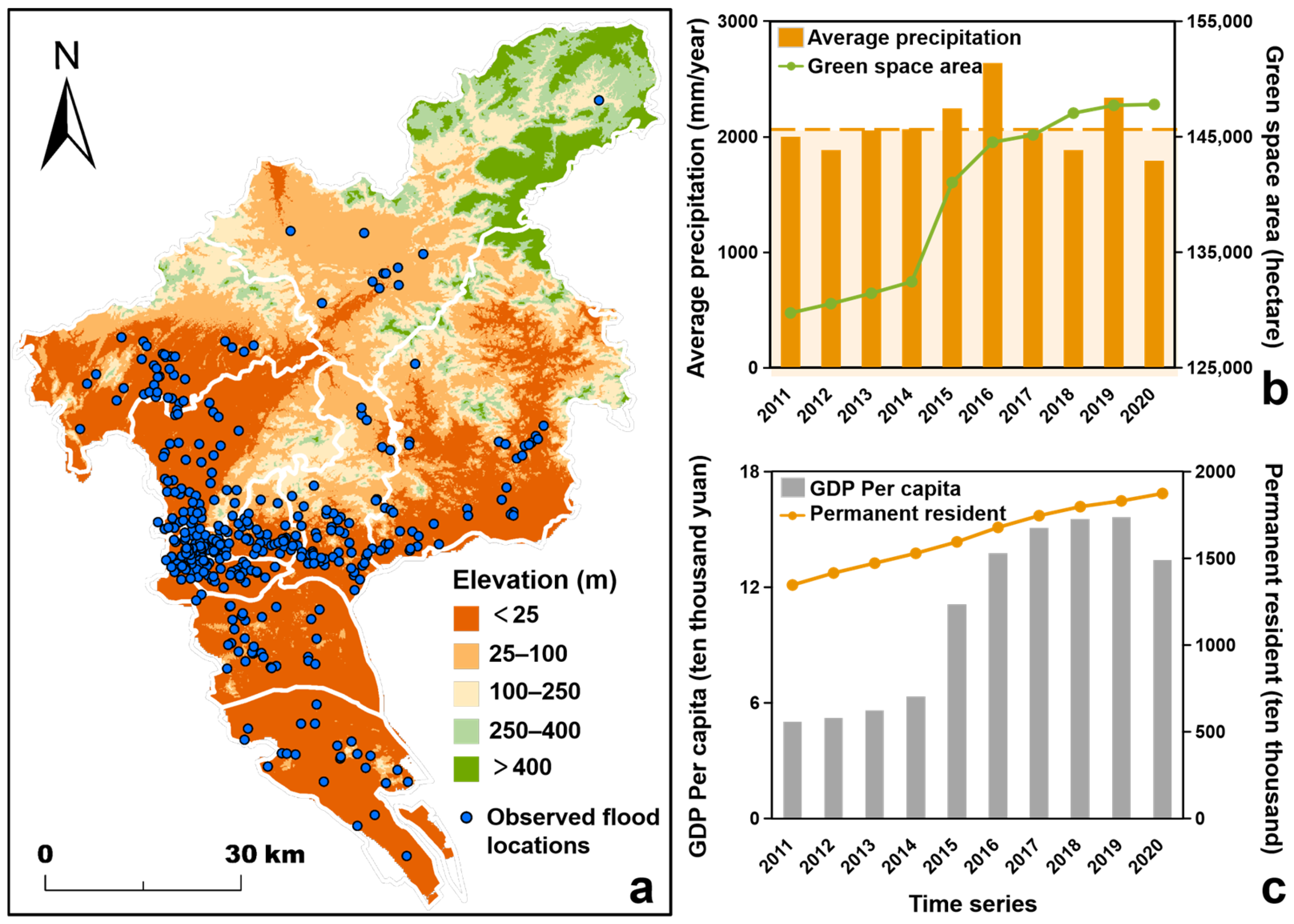
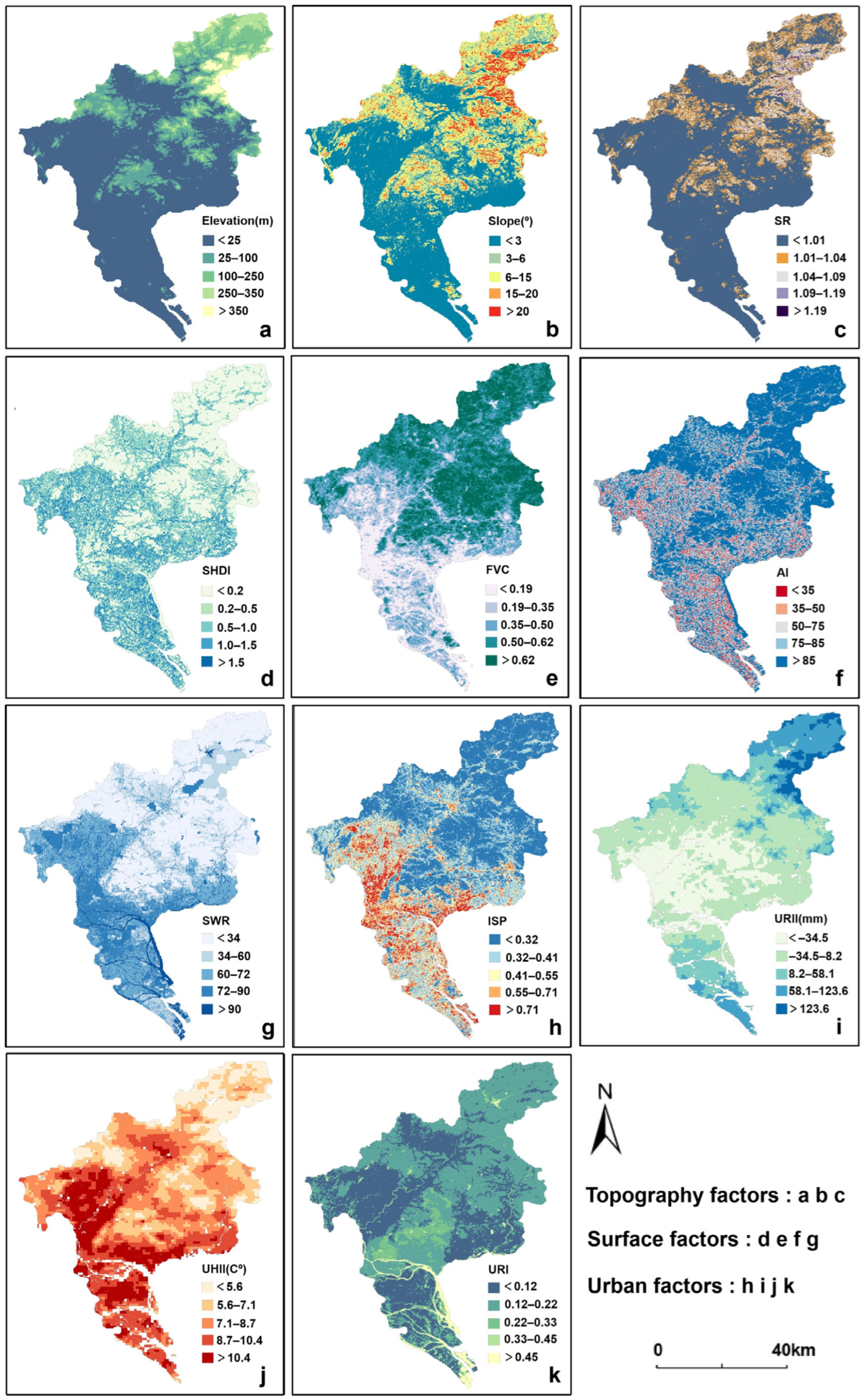
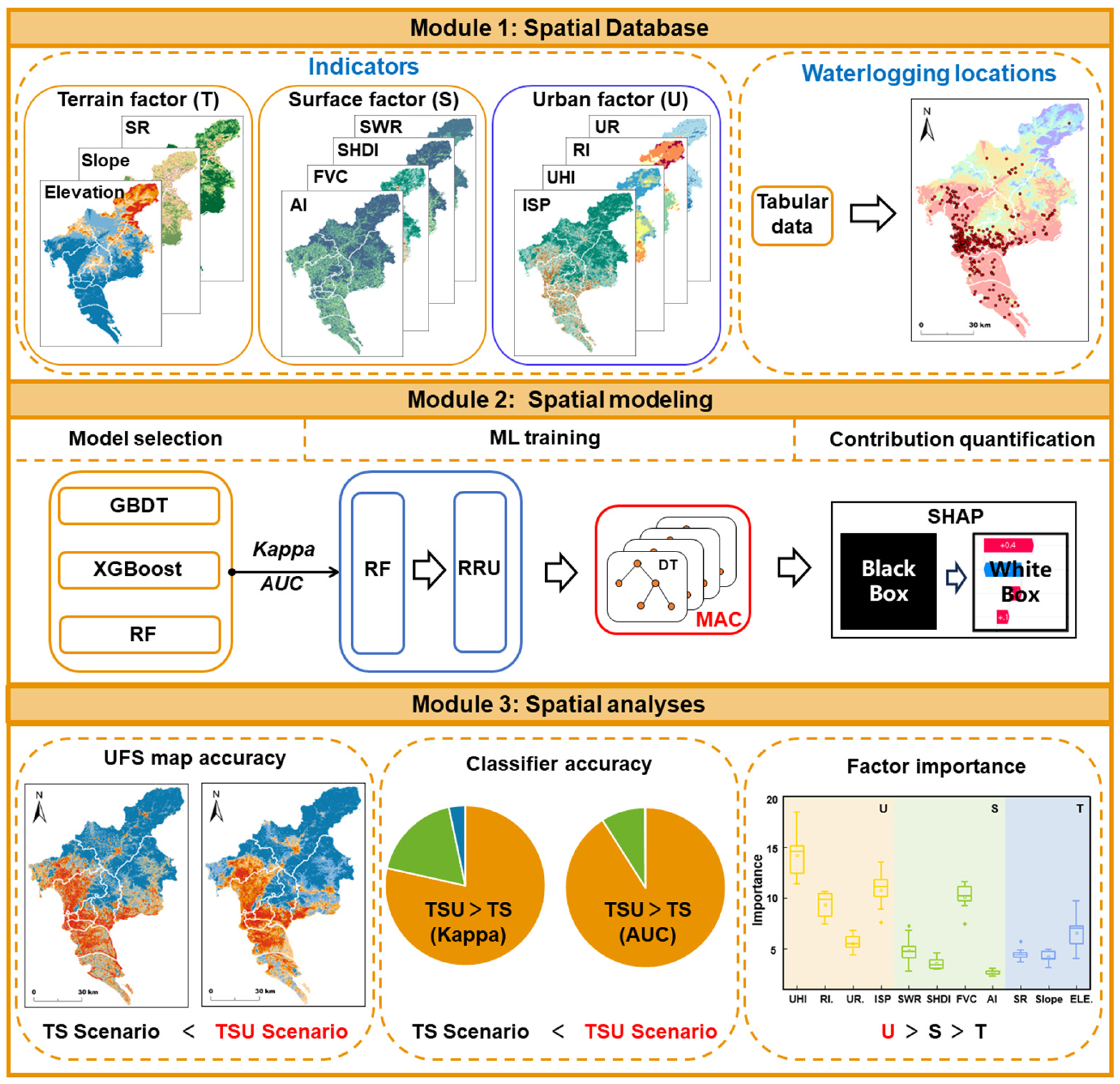
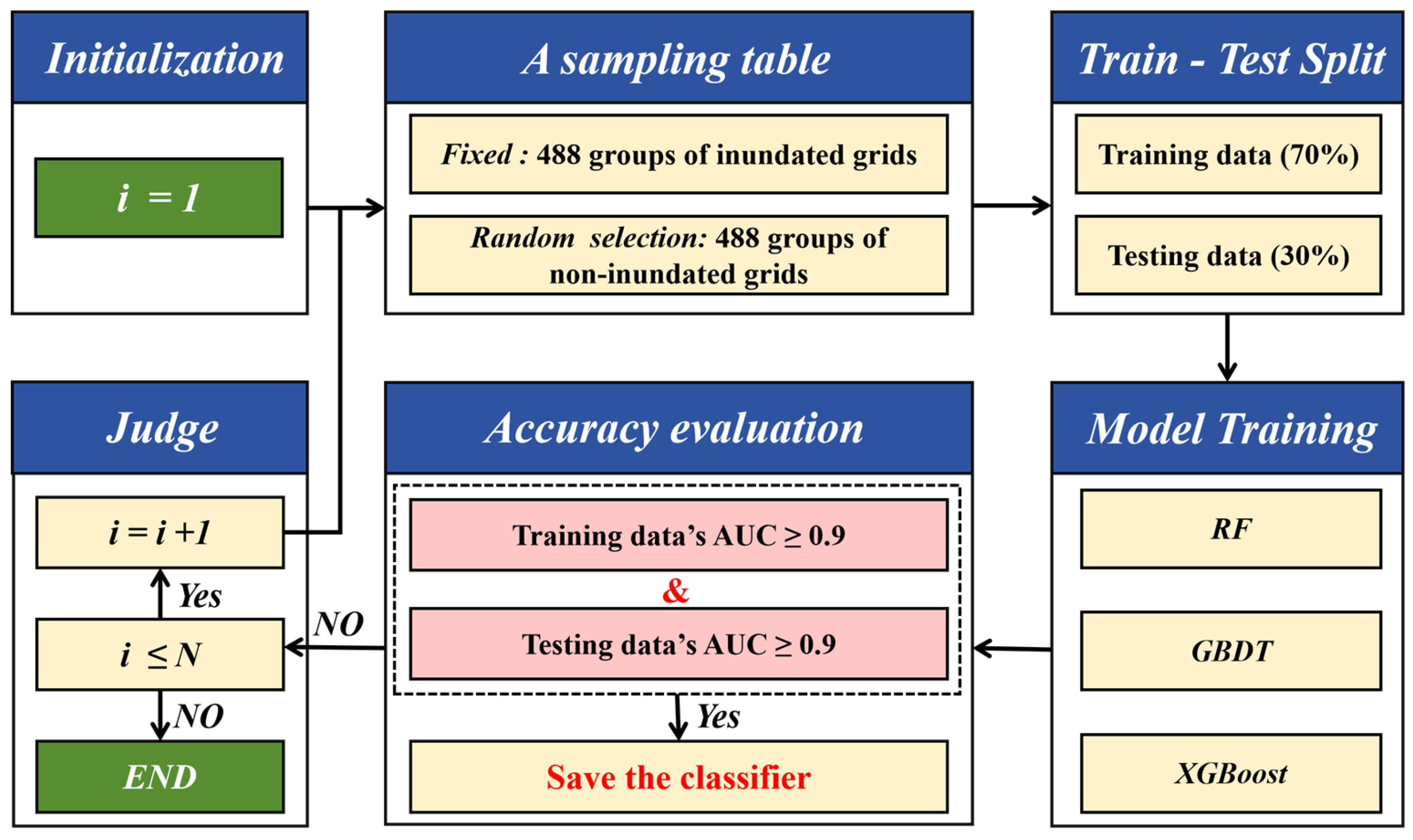
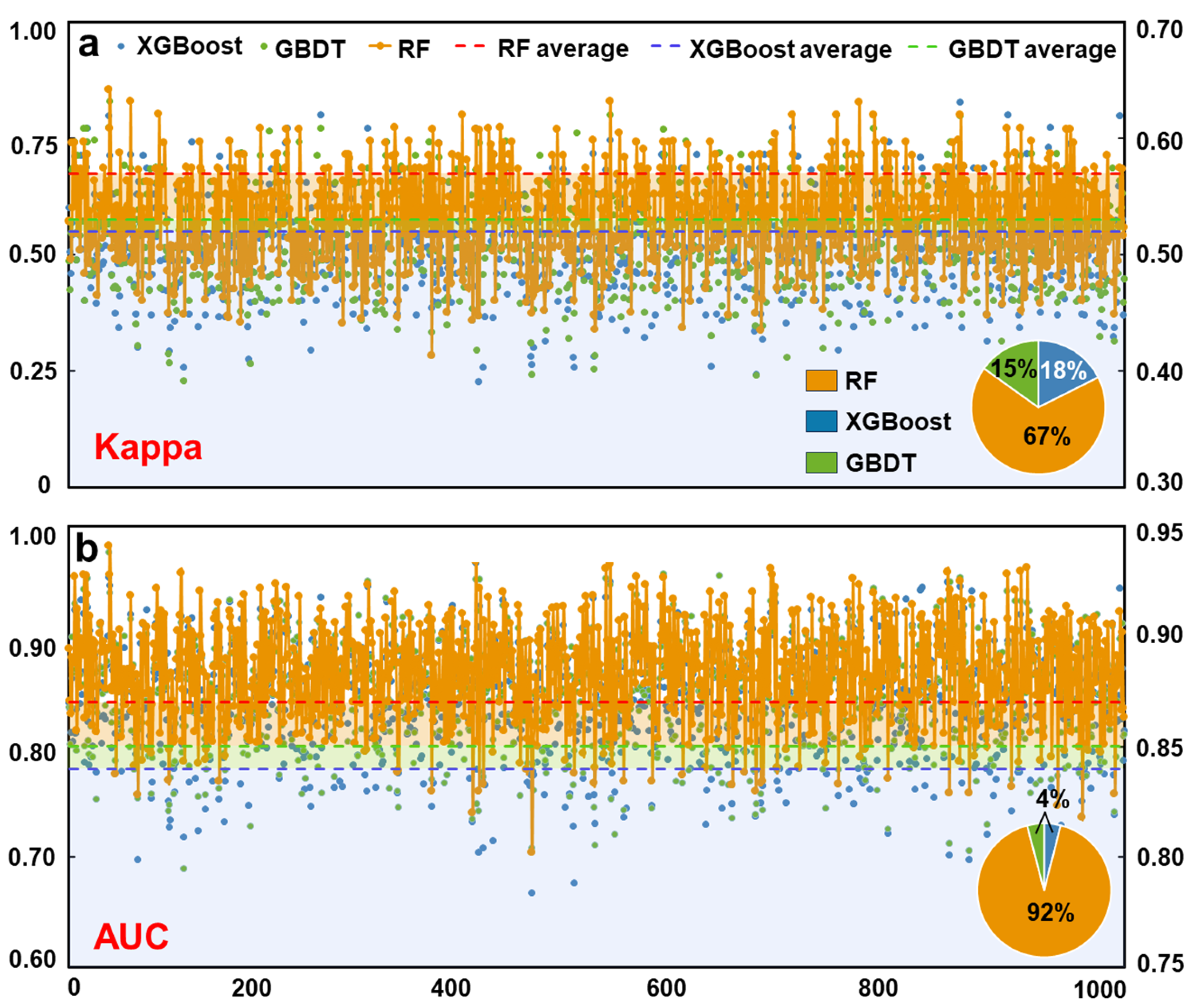

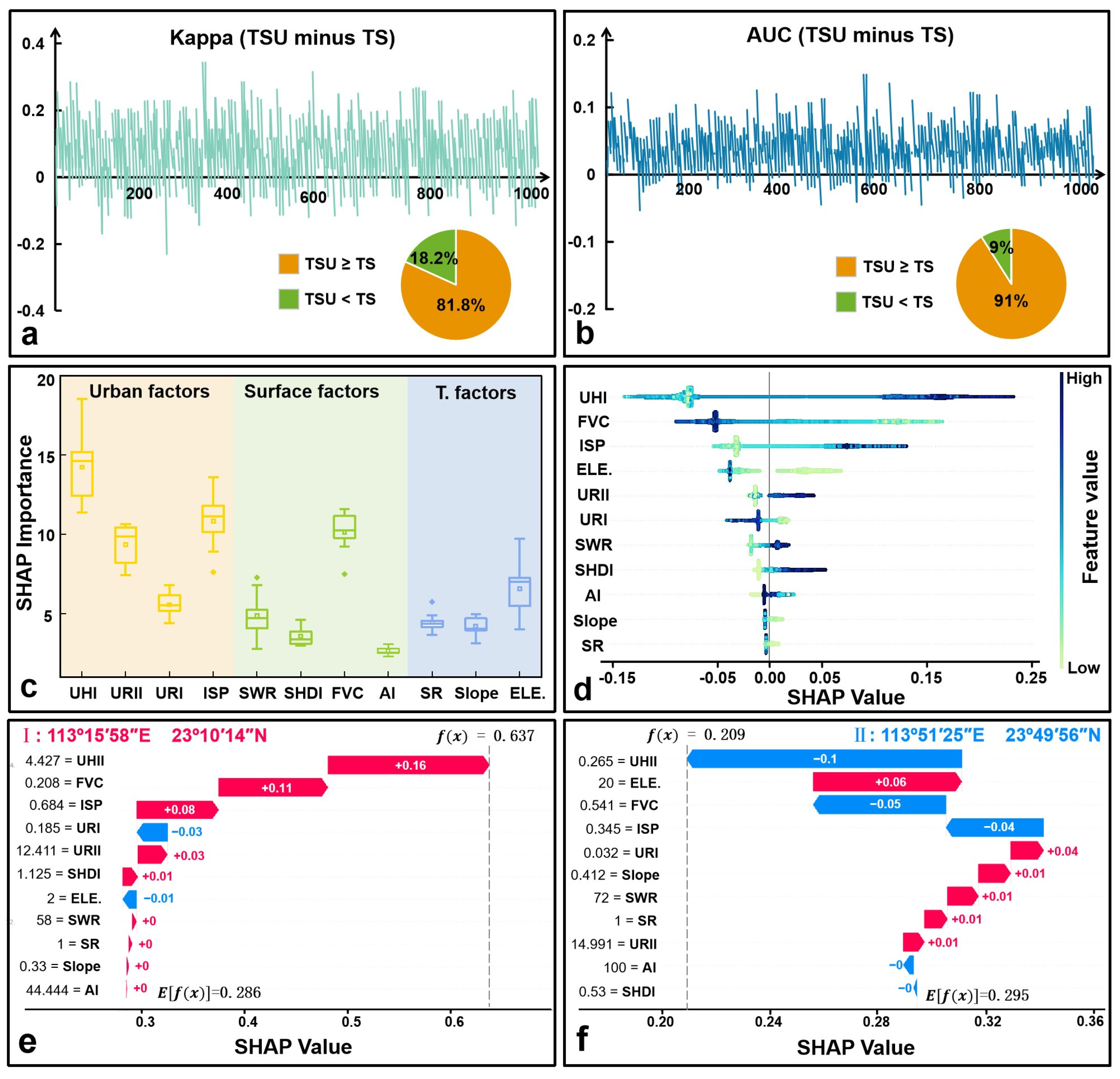
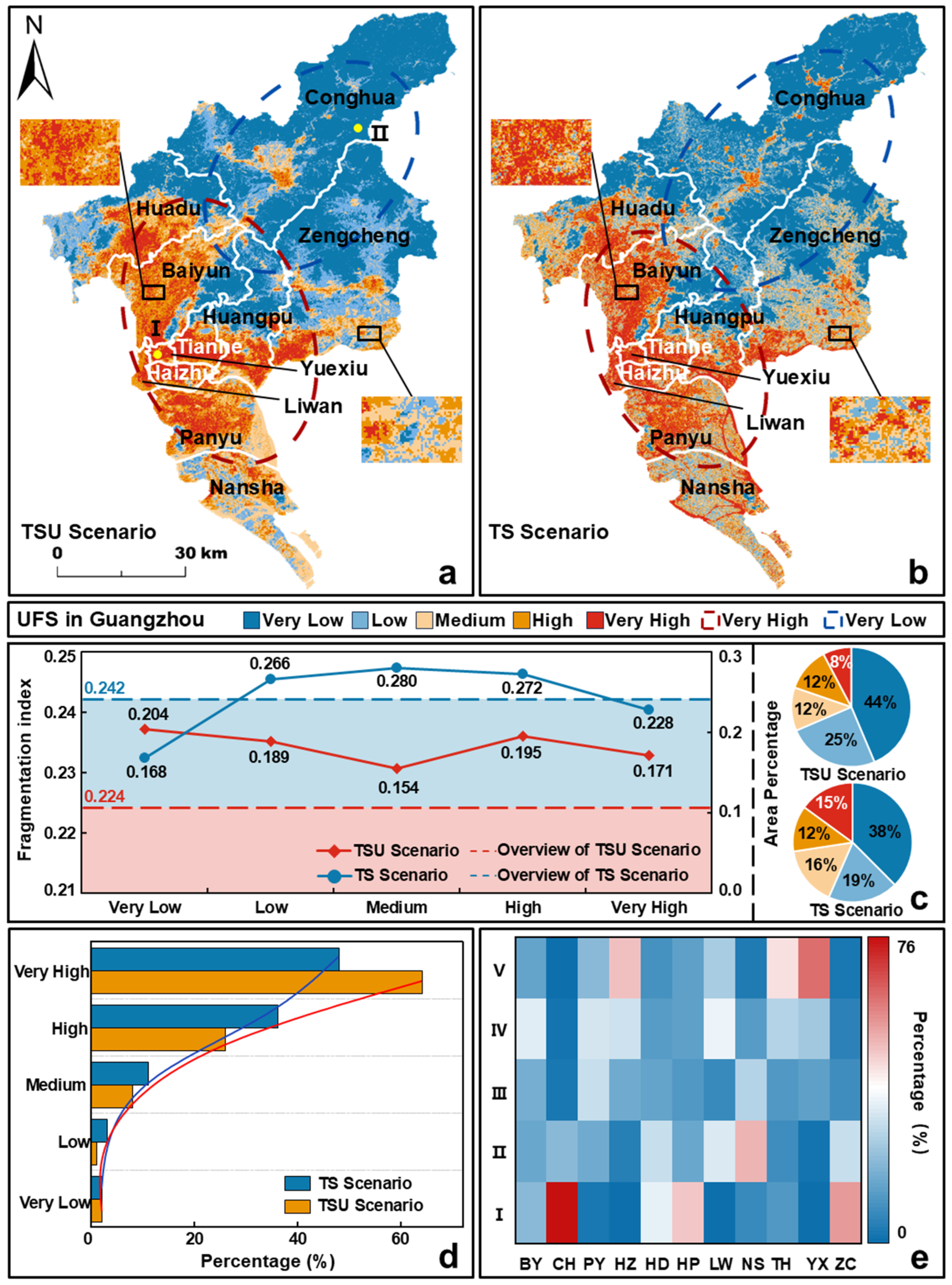
| Model | Parameter Name | Parameter Value |
|---|---|---|
| RF | n_estimators: Number of trees | 500 |
| max_depth: Maximum depth of trees | default value | |
| max_features: Maximum number of features to consider when finding optimal split | 3 | |
| GBDT | n_estimators: Number of trees | 500 |
| max_depth: Maximum depth of trees | default value | |
| max_features: Maximum number of features to consider when finding optimal split | 3 | |
| XGBoost | n_estimators: Number of trees | 500 |
| max_depth: Maximum depth of trees | default value | |
| max_features: Maximum number of features to consider when finding optimal split | 3 | |
| colsample_bytree: Proportion of features used in each tree | 0.33 |
| Variables | DEM | Slope | SR | FVC | AI | SHDI | SWR | ISP | UHI | RI | UR |
|---|---|---|---|---|---|---|---|---|---|---|---|
| Tolerance | 0.370 | 0.112 | 0.138 | 0.205 | 0.257 | 0.222 | 0.421 | 0.352 | 0.238 | 0.368 | 0.740 |
| VIF | 2.702 | 8.929 | 7.269 | 4.870 | 3.897 | 4.505 | 2.376 | 2.840 | 4.195 | 2.714 | 1.351 |
| Abbreviation | Kappa | AUC |
|---|---|---|
| TSU Scenario | 0.868 | 0.864 |
| TS Scenario | 0.807 | 0.829 |
Disclaimer/Publisher’s Note: The statements, opinions and data contained in all publications are solely those of the individual author(s) and contributor(s) and not of MDPI and/or the editor(s). MDPI and/or the editor(s) disclaim responsibility for any injury to people or property resulting from any ideas, methods, instructions or products referred to in the content. |
© 2025 by the authors. Licensee MDPI, Basel, Switzerland. This article is an open access article distributed under the terms and conditions of the Creative Commons Attribution (CC BY) license (https://creativecommons.org/licenses/by/4.0/).
Share and Cite
Tian, J.; Chen, Y.; Yang, L.; Li, D.; Liu, L.; Li, J.; Tang, X. Enhancing Urban Flood Susceptibility Assessment by Capturing the Features of the Urban Environment. Remote Sens. 2025, 17, 1347. https://doi.org/10.3390/rs17081347
Tian J, Chen Y, Yang L, Li D, Liu L, Li J, Tang X. Enhancing Urban Flood Susceptibility Assessment by Capturing the Features of the Urban Environment. Remote Sensing. 2025; 17(8):1347. https://doi.org/10.3390/rs17081347
Chicago/Turabian StyleTian, Juwei, Yinyin Chen, Linhan Yang, Dandan Li, Luo Liu, Jiufeng Li, and Xianzhe Tang. 2025. "Enhancing Urban Flood Susceptibility Assessment by Capturing the Features of the Urban Environment" Remote Sensing 17, no. 8: 1347. https://doi.org/10.3390/rs17081347
APA StyleTian, J., Chen, Y., Yang, L., Li, D., Liu, L., Li, J., & Tang, X. (2025). Enhancing Urban Flood Susceptibility Assessment by Capturing the Features of the Urban Environment. Remote Sensing, 17(8), 1347. https://doi.org/10.3390/rs17081347









